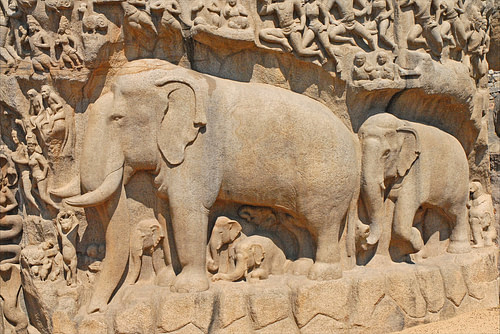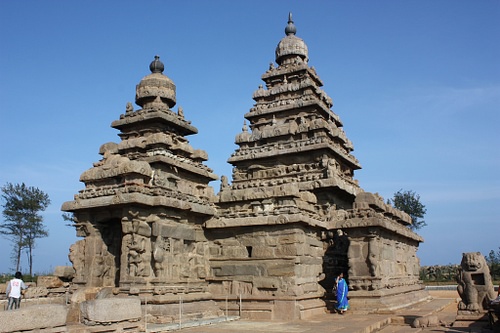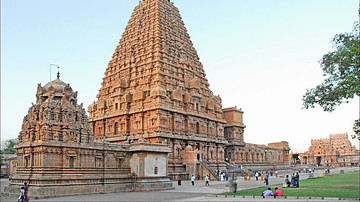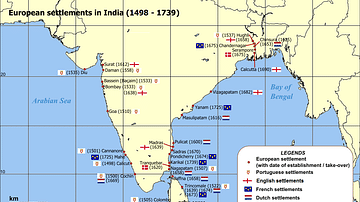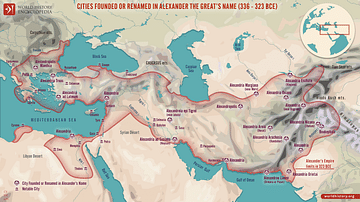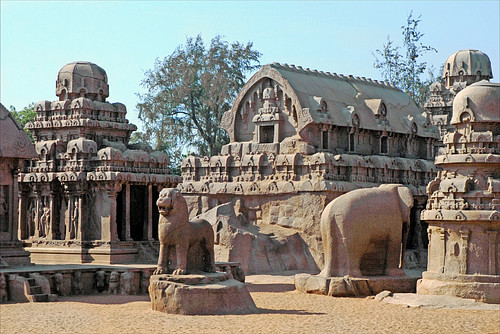
Mahabalipuram or Mamallapuram is a historic city and UNESCO World Heritage site in Tamil Nadu, India. During the reign of the Pallava dynasty, between the 3rd century CE and 7th century CE, it became an important centre of art, architecture and literature. Mahabalipuram was already a thriving sea port on the Bay of Bengal before this time. A significant amount of coins and other artefacts excavated from this region also indicate a pre-existing trade relation with the Romans even before it became a part of the Pallava Empire.
Early History
Mahabalipuram's early history is completely shrouded in mystery. Ancient mariners considered this place the land of the Seven Pagodas. There are others who think that Mahabalipuram suffered from a great flood between 10,000 and 13,000 BCE. Controversial historian Graham Hancock was one of the core members of a team of divers from Indian National Institute of Oceanography and the Scientific Exploration Society based in Dorset, UK who surveyed the ocean bed near Mahabalipuram in 2002 CE. He is more inclined to believe the flood theory. His exploration also afforded him a fair glimpse of the vast extent of submerged ruins of the city. After his underwater exploration, he reportedly commented, “I have argued for many years that the world's flood myths deserve to be taken seriously, a view that most Western academics reject … But here in Mahabalipuram, we have proved the myths right and the academics wrong.”
Many opinions exist about the origin of the name of the site too. The most popular explanation is that the place is named after benevolent King Bali, also known as Mahabali. The ancient Indian text of Vishnu Puran documents his exploits. After sacrificing himself to Vaman, an incarnation of Vishnu, he attained liberation. “Puram” is a Sanskrit term for a city or urban dwelling. Mamallapuram is the Prakrit version of the original Sanskrit name.
During the rule of Mahendravarman I (600 CE – 630 CE), Mahablipuram started to flourish as a centre of art and culture. He himself was a well known poet, playwright and orator. His patronage helped the creation of a number of the city's most iconic landmarks. This period of artistic excellence was duly continued by his son Narasimhavarman I (630 CE – 680 CE) and subsequent Pallava kings.
Art & Architectural Masterpieces
Cave Temples
The Adi Varaha Perumal Cave Temple is the earliest of all Pallava structures in Mahabalipuram, yet the least visited one. The grandeur of the actual mandapa (pavilion) is hidden behind a rather ordinary looking latter-day structure. The construction of this site began before the reign of Mahendravarman I. The temple is dedicated to Vishnu (Varaha is an incarnation of Vishnu) and its execution follows the spirit of Vaishnava Agamic texts. Both the outer hall and sanctum sanatorium are adorned with elaborate relief sculptures. This temple houses two relief sculptures of Pallava kings, Simhavishnu (c. 537 CE – 570 CE) and Mahendravarman I, accompanied by their respective wives.
The Trimurti Cave is dedicated to the trinity of Brahma, Vishnu and Maheswara (Shiva) representing the process of creation, sustenance and destruction. Aside from the deity, the carved pillars and sculptures also show devotees in various postures. The Varaha and Krishna Caves exhibit mythical tales related to Vishnu and Krishna.
The Mahishasuramardini Cave can be found at a hilltop location. Mahishasuramardini is another name of the goddess Durga who is an incarnation of Shakti (power). She earned this name after the slaying of the demon Mahishasura. This is the second, along with the Kotikal Cave, of the caves dedicated to Durga.
Technically speaking, the Yali or Tiger Cave may not be a geographic fissure, but it boasts a set of most elaborately designed pillars and sculptures depicting several mythical creatures, lions and tigers. This also has a relief sculpture dedicated to Narasimhavarman II or Rajasimha (700 CE – 728 CE). In many ways, the Tiger Cave sums up the evolution of the Pallava's cave temple structures over a period of time.
Descent of the Ganges
Alternatively known as Arjuna's Penance, Descent of the Ganges is a gigantic open air bas-relief sculpted out of pink granite. The dramatic relief sculpture narrates the tales from Indian epics such as the Mahabharata. Nearby mandapas, particularly the Krishna Mandapa, however, showcase scenes of pastoral life amid mythical figures. Other similar rock artworks close by have been left unfinished due to some unexplained reason.
Pancha Ratha
Pancha Ratha (five chariots) is an architectural ode to Mahabharata's five Pandava brothers Yudhistir, Bhima, Arjuna, Nakula, Sahadeva, and their wife Draupadi. Thematically and structurally, each ratha is significantly different from the other ones, but all of them were carved out of a long stone or monolith. Spread over one to three storeys, their forms vary from square to apsidal. The walls of these ancient edifices are decorated with bas-reliefs and murals. A beautifully carved monolithic airavata (elephant) and nandi (bull) decorate the premises. Though originally meant to be places of worships, these were never consecrated and used actively for any sacred rites.
Shore Temple
The Shore Temple is located on the beach and if local lore is to be trusted it is the one surviving structure of the legendary Seven Pagodas. Despite continuous erosive effects of the moist and salty sea air, the Shore Temple preserves its beauty in many parts. Built between 700 and 728 CE during the reign of Narasimhavarman II, this is indeed a remnant of a larger complex of temples and civil structures much of which lie under the depth of the sea now.
This five story edifice is so situated that the first rays of the rising sun fall on the presiding deity of the temple, Shiva. Visitors enter the premises through a barrel vaulted gopuram (gateway). The shikhara (roof) of the actual shrine resembles a pyramidal structure. Like other remarkable structures at Mahabalipuram, this too is embellished with intricate bas-reliefs. Monolithic sculptures are also seen scattered about the temple complex.
Olakkanneshvara Temple
Also known as the Olakkanatha Temple, the Olakkanneshvara Temple (Temple of Shiva, suggestive of the third eye of Shiva) was built about the same time as the Shore Temple. This is located atop a hill some distance away from the beach which gave birth to a belief that it acted as a lighthouse in earlier times. This is also built atop the Mahishasuramardini Cave, but the two are different structures erected at different times.
Mahabalipuram Today
There is another curious structure known as Sri Krishna's Butter Ball that fascinates everyone in Mahabalipuram. It is not a sculpted piece but more of a handiwork of nature. Today, Mahabalipuram is trying to re-create its image as the country's premier beach resort but it has not completely lost touch with its past cultural exploits. Every year, it hosts classical dance and drama festivals to preserve and promote the heritage of a very ancient culture.
Ironically, while the tsunami in 2004 CE created substantial damage to the existing structures and left the city water-logged for days, it also unearthed some of the treasures long hidden in the bosom of the sea. Granite sculptures, bronze statues and ruins of what seem to be manmade structures came to the fore. Underwater archaeologist Dr Alok Tripathi commented, “As the tsunami waves receded, they scoured away sand deposits that had covered these sculptures for centuries.” The underwater survey of Mahabalipuram is an ongoing process that promises to reveal many more of the city's grand edifices and solve some of the long standing questions about its past.

